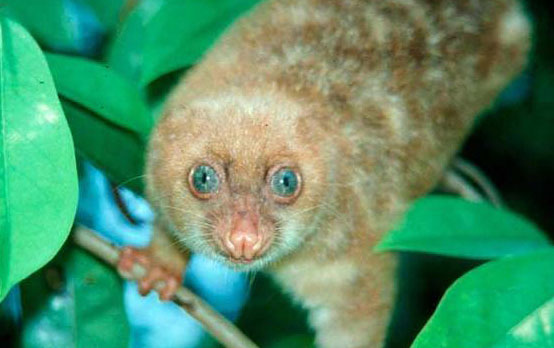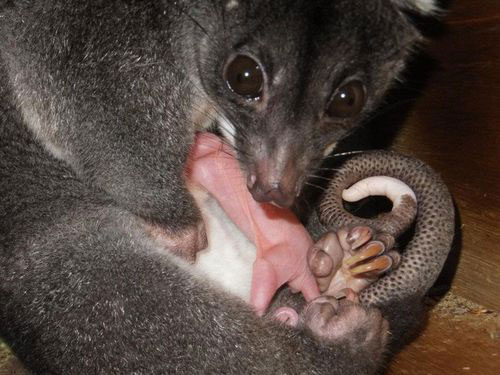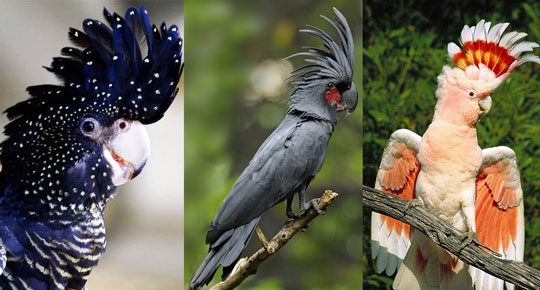|
I enjoy featuring animals that show up in my novels. Today's Awesome Animal appears in Infusion. Haven't read Infusion yet? Hmm... you know, there's a painless and reliable cure for that unfortunate condition. Anyway, there is a scene where Bobby asks the Lamotelokokhai to prove to him that it has detailed knowledge of every living creature it has ever encountered in the past. The result of this request is rather shocking. I'll just say it involves creating a Cuscus, an unusual and extremely adorable creature. So what the heck is a Cuscus? Pronounced "cuss-cuss." Like many of the mammals of Australia, New Guinea, and the surrounding islands, cuscuses are marsupials (their young develop outside the mother's body in a pouch). Generally, they are considered possums, and there are four genera and about 23 species (although since they live high in the canopy of remote tropical forests, it wouldn't surprise me if a few more species were eventually discovered). Okay, before I go on to the amazing facts, just take a moment to look at the photo above. Check out that face! I think I need to nominate the cuscus as the animal most likely to be mistaken for a cartoon character. Amazing facts about Cuscuses I mentioned above that it is possible new cuscus species could be found. This is because they live in some of the most inaccessible forests in the world. In fact, a new species was discovered in 2009, in the forest that covers an inactive volcano in Papua New Guinea called Mount Bosavi. It was named the Bosavi Silky Cuscus. See image below. And check out this video of the discovery of the Silky Cuscus in 2009. Most cuscuses are about the size of a housecat (body length about 18 inches with a tail about the same length). They have round heads with small ears that are usually hidden by fur, which makes that tennis ball-like head seem even more spherical. But one of the most amazing things about their appearance is their colors. They can be black, brown, gray, and sometimes lighter colors such as tan, white, or cream. In fact, they can even be a mix of these colors, with a spotted or mottled appearance. Because of this, they are perhaps the most colorful of all marsupials. The females and males often have different colors, allowing us to distinguish between genders. And their colors often change as they mature. Check out the spotted cuscus featured on this Papua New Guinea stamp: Cuscuses spend almost their entire lives in trees. To help them climb, they have some interesting adaptations. For example, they have prehensile tails that look almost like very long fingers. These tails can grip so hard that it is difficult for a person to loosen them if the cuscus is determined to hold on. They also have opposable digits, like a human's opposable thumb, only cuscuses also have opposable toes. The biggest danger to cuscuses is the loss of tropical forest habitat. And their main predator of is humans. They are widely hunted for food and their fur, especially in New Guinea. Other than humans, they are sometimes eaten by pythons and birds of prey. Cuscuses usually sleep on branches in the open, with their heads tucked between their legs. To help with camouflage, they sometimes pull leaves and branches over their bodies. However, there are some species (like the Ground Cuscus, pictured below) that live in burrows and move to the trees at night to feed. Cuscuses are marsupials, so they give birth to young after a very short gestation period, typically only a couple weeks. But then the babies crawl to the mother's pouch, where they continue to develop for six to seven months. Oddly enough, although two to four are usually born, only ONE will survive and emerge from the pouch to live on its own. Okay, I think I've decided what it is about the appearance of these creatures that intrigues me so much. It's their eyes! Obviously, cuscus eyes are adapted for seeing at night. But the way they are arranged on the face for looking forward and the bulging roundness of them gives these creatures an appearance unlike any other mammal. Below is the Sulawesi Bear Cuscus. So, the cuscus deserves a place in the M.B.A.H.O.F. (Mind-Blowing Animal Hall of Fame). FUN FACT: The term mind-blowing originated in the 1960s drug counterculture. Its original meaning was producing hallucinatory effects. But it has gradually evolved to have a more general meaning: something that is so shocking, surprising, unexpected or wonderful that your brain cannot comprehend it. So it is another way to say awesome. Photo Credits:
Bluer-eyed Cuscus - Australian Geographic Bosavi Silky Cuscus - National Geographic Spotted Cuscus on PNG stamp - Post PNG Baby Ground Cuscus - ZooBorns Sulawesi Bear Cuscus - Indonesia Travel
0 Comments
Recently I've tossed out some hints regarding my next book, Bridgers. Here's a bit more. Let's say the remarkable concept of infinite parallel universes has been proven to be true, and humans have constructed a device that can send you to another version of Earth for 36 hours. One of the interesting aspects of this device, though, is that you can "dial back" to any point of divergence you want. Warning - Crazy Explanation: Infinite universes really does mean INFINITE. There is another universe for every possible combination of atoms. So there are universes nearly identical to ours and those that are vastly different. The device mentioned above allows you to choose how far back your destination world diverged from our own. Let's say you choose to visit a world that diverged from ours ten minutes ago. This means the world was identical to ours in every way up until ten minutes ago. But for the last ten minutes, events on that world have been independent of our world. Not much can happen in ten minutes, so that world would be very similar to ours, including all the people (except for those who died in that ten minutes on one world but not on the other). If you choose a world that diverged ten years ago, it would still be similar. But a lot can happen in ten years. Elections could have resulted in different leaders, for example, resulting in somewhat different social landscapes. What about a world that diverged 100 years ago? None of the same people would exist, except those who are more than 100 years old. What about 1,000 years ago? That world could look quite different, right? Different languages, different political boundaries. Maybe even the extinction of life on Earth due to imprudent use of nuclear weapons. What about a world that diverged 10,000 years ago? Or 100,000? or 100 million? Boggles the mind, doesn't it? Keep in mind this isn't time travel. If you leave this world on December 12, it will be December 12 on the alternate version of Earth you visit. But you get to choose how far back the world diverged from ours.
So here is a question for you: If you had the opportunity to visit an alternate version of Earth, how far back would you want the divergence point? I would love to hear your opinion on this. I invite you to Comment to this post and give me your thoughts. I am almost done writing my new book, Bridgers! Did you know the concept of infinite parallel universes is more than just fodder for science fiction stories? The concept has actually long been considered by physicists to be a real possibility. It is important to point out that multiple universes is not a theory. Scientists did not suddenly come up with the idea using their imaginations. Instead, the concept is a mathematical consequence of our current theories in physics, particularly quantum mechanics and string theory. What this means, essentially, is that even those physicists who are skeptical of the idea must examine it as a real possibility (even if they do so reluctantly). I have an academic background in biology. Fortunately for me, my father and one of my brothers are physicists, and sometimes I can run my wild ideas by them for feedback. For my new upcoming series, I have placed the infinite universes concept into a framework of adrenaline-fueled wilderness survival. If you have enjoyed the fantastic creatures, danger, narrow escapes, and interesting characters of my Diffusion series, you are going to love my new books. I'm going to reveal the title of the first book: Bridgers What are bridgers, you ask? They are people hired to protect "tourists" paying large sums of money to bridge to an alternate version of Earth. Bridgers have specialized skills. They are experts at wilderness survival, making primitive weapons from available materials, and most of all, hand-to-hand fighting.
Why? Because bridging to an alternate world strips away all nonliving matter from your body. Thirty-six hours. No weapons, no clothing, no knowledge of your destination environment. It's the ultimate adventure excursion. I'll share more details soon. I'm hyper-excited about it! I enjoy featuring awesome animals that show up in my novels. Today's Awesome Animal appears in Diffusion and Savage (and maybe others?). So what the heck is a Cockatoo? Cockatoos are parrots. There are about 21 species of cockatoos, making up the family of birds known as Cacatuidae. Perhaps the most recognizable thing about cockatoos is their spectacular crest, a group of feathers on top of their heads that they can raise and lower when circumstances require it. They are also typically less colorful than some of the other parrots. Most cockatoos are white, but some are pink, gray, and a few are black. Cockatoos live in Australia, New Guinea, and many islands of the Malay Archipelago. Below is a sulfur-crested cockatoo. Amazing facts about Cockatoos Cockatoos are loud! Their screeches and squawks can make your ears ring, and they can be heard a mile away. BUT... I must add that many reports of their volume are exaggerated. It is common to read that they are louder than a 747 jet. Cockatoos (particularly the Molluccan cockatoo, which is one of the loudest) can put out 135 dB of volume. Let's assume that was measured at about 3 meters away, which is what you would hear if you were in the same room. A jet engine puts out about 150 dB at 30 meters. Without getting into the math to prove it, this roughly means that at 170 meters away, the jet engine would be about as loud as the cockatoo at 3 meters away. So the claim that cockatoos are louder than a jet engine are not entirely accurate (calculations with the numbers provided above reveal that the jet engine puts out about 3000 times more sound energy than the cockatoo). But regardless, these birds are insanely LOUD. You would not want to have a pet cockatoo in an apartment building. Check out this video of a loud Umbrella Cockatoo. Cockatoos can bite hard! Most parrrots can bite hard because they feed on nuts and fruits that are very difficult to tear into or crack open (not to mention they use their beaks to help them climb). But unlike other parrots, cockatoos' lower mandibles have two prongs. Along with the curved single point of their upper jaw, this gives them what is called a three-way bite. So they can do more damage than other birds their size. Reports of jaw strength of parrots vary widely, but it appears that the large macaws can bite with a force of about 400 psi (pounds per square inch), and the larger cockatoos can bite at about 350 psi. Youch! In fact, wild cockatoos are known to cause considerable damage to houses and anything else made of wood. Not all cockatoos are white. Although we typically see several of the white species in pet shops, other species of cockatoos can be a variety of beautiful colors. Below (from left to right) is the Red-Tailed Black Cockatoo, the Black Palm Cockatoo, and the Pink Cockatoo (also called the Major Mitchell's Cockatoo). Cockatoos live a long time. The smallest of the cockatoos, the cockatiel (a very common pet bird) lives 10 - 14 years. But most of the larger cockatoos live 40 - 50 years. Keep in mind, though, that this is their lifespan in captivity, where they tend to live much longer than in the wild. The White Cockatoo has an average life span of 40 - 60 years. Supposedly, the longest-lived cockatoo ever was Cocky Bennett. Cocky was a sulfur-crested cockatoo that lived at the Sea Breeze Hotel at Tom Uglys Point, Blakehurst (New South Wales, Australia). Cocky was known for his "patter." He died in 1916 at the age of 120 years! See photo below. Whether you consider this a good thing or a bad thing, what really boosted the popularity of cockatoos as pets was a 1970s crime show on television. When I was a teenager, I used to watch Baretta, a refreshigly (for its time) gritty cop show about the detective, Tony Baretta (played by Robert Blake). Tony was kind of a loner, but he took comfort in talking to his pet sulfur-crested cockatoo, Fred. Cockatoos are actually wild animals. I know, this seems obvious, but almost all of the available information on cockatoos has something to do with keeping them as pets. But if you read the information above, there are very good reasons to NOT keep them as pets. They are LOUD. They BITE hard. And they can OUTLIVE their owner. So let's not forget that cockatoos are amazing wild birds that are worth understanding better. I have been fortunate enough to travel to Australia only once, back in 1995 (although Trish and I are planning to go again in 2018!!). I remember the first time I saw cockatoos in the wild. We visited Fitzroy Island, and they were common there, chattering and feeding in the trees. I was so enthralled by them! So, as a reminder that cockatoos are not just popular pets, check out this video on the wild parrots and cockatoos of Australia. So, the cockatoo deserves a place in the B.A.H.O.F. (Brilliant Animal Hall of Fame). FUN FACT: The word brilliant originated in about 1680, as the french word, brillant, meaning shining. It has always, and still does, mean sparkling or shining brightly. But it has also evolved (especially in British English) to mean splendid or magnificent, which is a perfect fit for cockatoos. In other words, it is another way to say awesome. Photo Credits:
Sulfur Crested Cockatoo #1 - San Diego Zoo Cockatoos chewing wood - Samantha Dunn Colorful Cockatoos - Pinterest Cocky Bennett - Archive of Sutherland Shire Libraries, Australia Baretta and Fred - NBC News |
Stan's Cogitations
Everyone needs a creative outlet. That's why I write. Archives
July 2024
|














 RSS Feed
RSS Feed